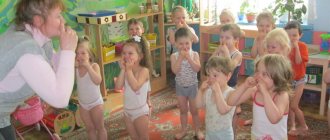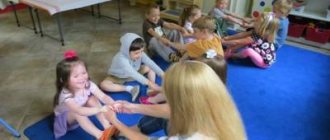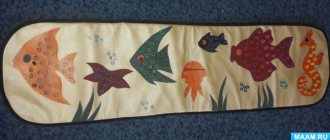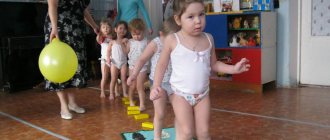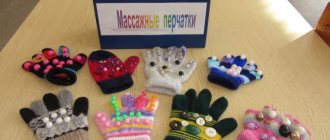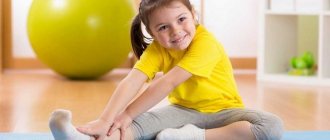The influence of gymnastics, effect
You need to understand that if a child has a disease that causes decreased vision - myopia, hypermetropia, astigmatism - he needs constant vision correction with glasses or lenses. However, many years of practical experience have proven that with mild and moderate myopia, general strengthening measures and exercises (gymnastics) for the eyes contribute to:
- improving blood supply and nutrition of eye structures;
- eliminating eye strain and quickly “unloading” it;
- reducing the possibility of ciliary muscle spasm or reducing its degree;
- strengthening the external muscles of the eye;
- strengthening the sclera (outer shell of the eye), which has a stabilizing effect, eliminating changes in the size of the eye as myopia increases.
How to do eye exercises correctly? Set of exercises
For maximum efficiency, starting each lesson, especially at home, is recommended with a light massage with the pads of the fingers of the periorbital area and eyeballs through the eyelids, which improves blood supply and tissue nutrition not only in these areas, but also in the eyeball (G.G. Demirchoglyan, A .G. Demirchoglyan 2000) – all exercises must be done only as prescribed by a doctor and very carefully!
Exercise 1 . Using the pads of your index fingers, with gentle pressure and vibration, glide over the skin in the superciliary area, moving from the center to the temples.
Exercise 2 . Using the pads of your index fingers, with gentle pressure and vibration, slide along the skin at the lower edge of the eye socket, moving from the center to the temples.
Exercise 3 . Using the pads of your index fingers, with gentle pressure, glide over the skin in the middle part of the upper eyelid, moving from the inner corner of the palpebral fissure to the outer one.
Each exercise is performed for 3 minutes . Next, repeat all the exercises, but using the pads of the index and middle fingers, i.e. expanding the massage area. The time to complete each exercise is 3 minutes. The use of hardware techniques and special masks at home in children is undesirable - since appropriate research and testing have not been carried out. Now let's move on to eye exercises.
Recommendations
Before starting classes with children, the following circumstances should be considered:
- You are dealing with a growing, not yet fully formed organism, which has fragile bones, so calculate your strength and do not put a strong load;
- Choose exercises that involve only smooth movements. Avoid harshness;
- Always consider the order of charging steps and do not ignore them;
Even in exercises, be systematic and orderly. That is, start with exercises for the upper body and end with the lower body.
Complex E.S. Avetisov, performed at school and at home
Designed to prevent myopia in school-age children. It helps strengthen the eye muscles and accommodative apparatus, improve the nutrition of eye tissue. Recommended for children with a genetic predisposition to myopia and young patients with the first signs of the disease. Avetisov’s set of exercises can be used to maintain visual acuity in children experiencing severe visual stress, as well as in cases of developed myopia. You should start the exercises with small loads, gradually increasing them over the course of a week.
A standard set of exercises for children can be “cut” in half on the first day of classes, then gradually, over the course of several days, bringing it to the desired level. Exercises should be performed regularly, without missing a day - otherwise the effect will be partial or absent altogether:
- Lean back in your chair, take a deep breath and bend forward to exhale. 5-6 repetitions.
- Lean back in your chair and close your eyes tightly for 5-6 seconds, then open them. Do 5-6 repetitions.
- Blink your eyes quickly for 15 seconds and 10 seconds without blinking. 3 - 4 repetitions.
- Sitting position, hands on the belt, turn your head to the right and look at the elbow of your right hand, then to the left and look at the elbow of your left hand. Initial position. 5-6 repetitions.
- Sitting position. Raise your eyes from the floor up to the ceiling. Rotate your eyes clockwise and counterclockwise - 6 rotations in each direction.
- Stretch your arms forward and look at your fingertips, raise your arms up as you inhale, watching your fingers without raising your head. Lower your arms as you exhale. 4-5 repetitions.
- Extend your hand in front of you, raising your thumb and fix your gaze on its tip for 3-5 seconds, then slowly bring your finger closer to your nose until it starts to double, without taking your gaze away from it and move your hand back to its previous position (up to 8 repetitions).
- Standing position. Slowly move your half-bent hand from right to left, fixing your gaze on the tip of the raised thumb and back. 10-12 repetitions.
- Close your eyes and use the tips of your index fingers to lightly massage them through your eyelids for 30 seconds.
During the period of mastering the complex, it is necessary to control that the child performs all movements correctly .
Exercises to complicate step 5 of the complex - “draw” geometric figures in space with your eyes: circle, square, triangle, vertical and horizontal figure eight.
Charging stages
Any physical activity includes several stages:
- Warm up. This stage helps to invigorate and prepare the body muscles for more active exercises. As a rule, it does not take too much time to complete it.
- Warming up To avoid problems during your workout, be sure to warm up with vigorous exercise, such as walking in place or jogging in place. For children, this helps to work out the muscles and tendons of the legs and prevent flat feet.
- The main part consists of more complex exercises that should be aimed at strengthening the muscles.
- Conclusion. Towards the end of the training, the child should switch to easier exercises, such as walking in place. This helps normalize blood pressure, even out breathing and simply relax.
Home complex “Mark on glass”
This exercise should be used after every 30 minutes of writing, reading and working with the computer:
- Attach a round mark with a diameter of 3-5 mm to the window glass at the child’s eye level.
- In the distance, in the line of sight, identify and name the child an object on which to fix his gaze.
- With two eyes, from a distance of 30-35 cm, the gaze is fixed on the mark for 2-3 seconds, then on a distant object for 2-3 seconds and again transferred to the mark.
- The first two days do the exercise for 5 minutes, the next - 7 minutes.
Perform the exercise 2-5 times a day. Use as an addition to the main complex.
Are there any contraindications for doing the exercises?
If there are complications caused by myopia, some conditions may be aggravated by exercise. This:
- retinal detachment (increased blood circulation and mechanical impact are not allowed);
- eye infections (conjunctivitis, blepharitis);
- eye injuries;
- severe myopia.
For strabismus and amblyopia (the so-called “lazy eye”), standard exercises designed for myopia are also not used. There are special sets of eye exercises for them.
The exercises included in children's complexes for myopia have a certain focus. Some exercises are designed to reduce eye fatigue, others to strengthen the eye muscles, and others to improve blood circulation or accommodation. For example, some scientists suggest psycho-emotional causes of eye muscle tension in children.
Remember that the choice of a specific set of exercises for myopia should rest entirely with the ophthalmologist. In this case, the general physical and psycho-emotional state of the child, the health of his eyes and the degree of myopia, as well as the lifestyle and age of the young patient should be taken into account.
Before performing exercises, you should definitely undergo a diagnostic examination and consult with an ophthalmologist.
Other sets of exercises for children with myopia
Bates complex
Literature about the system of William Horatio Bates and his student M. Corbett, the creator of non-drug treatment for refractive impairment of vision, based on the theory of accommodation due to the work of the oculomotor muscles and rejected by the world ophthalmological community in the 30s of the last century, like many other things, appeared in the Soviet Union during the period of "perestroika". The author of the work does not note that the developed system is intended for the prevention and treatment of myopia in children. There is no information about who and when this system was adapted for children in our country.
One of the cornerstones of the theory is to achieve complete relaxation of the extraocular muscles through autotraining (meditation), the so-called. “palming”, the technique of which probably will not be able to be mastered by a child of preschool and primary school age, because And it’s not easy for an adult to do this. Today, on the Internet, even on behalf of very well-known ophthalmological clinics (private), a large number of different variants of this system are presented, in which “palming” is reduced to simply closing the eyes with the palms of the hands. And without it, training according to the W. Bates system does not work. It is alarming that none of the authors offering the most well-known variants of exercise complexes using “palming” in the Russian Federation is an ophthalmologist.
In the Western world, there is a modification of the W. Bates system, proposed by M. Windolf, based on “palming”. But it is believed that the use of this method can cause stress and discomfort in the child; it has contraindications. There is no statistical data on the effectiveness of the W. Bates system. The following reliable fact deserves attention. One of the friends and ardent promoter of the W. Bates system, the famous novelist Aldous Huxley, demonstrating to the public his “victory” over “senile farsightedness,” read the text at close range, without using glasses, and suddenly fell silent. History is silent about how he got out of this situation. Later, in a private conversation, O. Huxley admitted that he had forgotten the text he had learned by heart.
Hardware treatment
To carry it out in domestic ophthalmology, many techniques have been developed. From classical physiotherapy (electrophoresis with medications, electrical stimulation of the ciliary muscle and optic nerve) to devices based on magnetic and laser effects.
For hardware treatment, the Visotronic device is sometimes used. Additionally, there are several computer programs that can be used to improve children's vision. Please note that we are talking about domestic developments. The fact is that until recently, Western practical schools did not consider myopia as a disease, but only as a visual condition that needed correction. Hardware treatment also has disadvantages. And first of all, these are the costs associated with regular visits to a medical facility. Secondly, the lack of a stable and long-term effect. You can hear your opinion on this matter in this video.
Eye exercises with simulators
There are also a lot of techniques in this section. The most famous are optical simulators and so-called “perforation glasses”. In the first case, combinations of glasses with a certain lens strength are used for training; in the second, a ruler with prisms of different strengths is used. Both methods are based on research. In the third option, against the backdrop of massive advertising, there is no clear understanding of the operating principle of this device, as well as statistics on its effectiveness. Like all of the above, exercise machines do not provide a permanent effect.
Exercises for preschoolers
The eye exercises for myopia given above are suitable for preschoolers as preventive measures.
It can be difficult for young children to understand what exactly their parents want from them, so adults are recommended to do the exercises with them. In this case, you should help small patients - for example, draw shapes with your fingers or trace them on cards.
You can use almost any object in the house to exercise with children.
For example, ask your child to look around the outline of the furniture. Or put stickers with figures on the walls and furniture and ask your child to look for the desired figure without turning his head. At the same time, the figures may differ in color, which has a positive effect on vision training.
What does morning exercise do for children?
Exercising in the morning has a beneficial effect on the functioning of the whole body. In the case of children, exercise or so-called gymnastics helps them wake up, strengthen their body, improve appetite, speed up metabolic processes, harmonize sleep and much more.
First of all, performing sports exercises instills in a child a desire for discipline and composure, which will be very useful to him in the future in adulthood.
- Moreover, it would seem that such a simple activity develops willpower in a little person, trains the spirit and increases endurance.
- Often, exercises for children are organized in kindergarten. There, trained specialists work with them, who are their educators or special trainers.
- Educators know which movements are suitable for exercise in young children and which are not. This is why the risk of injury is reduced to a minimum.
- However, not all parents send their children to kindergarten. And certainly not everyone adheres to the regime on weekends, when the child takes a break from visiting kindergarten.
- Unfortunately, parents find this activity boring, but what can we say about their kids? However, there is always a way out!
To make the process less boring, choose music to energize your children. Usually these are funny songs from good old Soviet cartoons or more modern melodies.
Music in the background will help your child understand the rhythm, and the lesson itself (even if it only lasts 15 minutes) will take place in a relaxed atmosphere.
Don't forget about visual hygiene!
A very important point in prevention is compliance with the rules of visual hygiene during visual stress at close range: prolonged reading and working with a computer. Breaks of 5-10 minutes every 30-40 minutes are required to perform the exercises. There must be sufficient lighting of the workplace (on the left side, not in the eyes, but on the table surface and not too bright), the correct position of the child’s body (without bending to the sides) in the workplace, maintaining a distance from the eyes to the object of visual work (30- 40 cm). Some recommendations for working with electronic devices:
- When using gadgets (for example, e-books), you should set the maximum font size everywhere.
- You should not read or use gadgets in low light; it is best to do this in diffused natural light.
- After every 15-20 minutes of working at close range, preschoolers and children of primary school age should perform the “Mark on Glass” complex.
- Don't forget about 2-hour walks in the fresh air with active games (especially those where the child needs to follow the ball, shuttlecock, focusing his vision on moving an object near and far).
- A proper diet without fasting or dehydration has a beneficial effect on the condition of the eyes. It is also recommended to include foods high in vitamins A, E and C and containing zeaxanthin and lutein.
Remember to take a comprehensive approach to preventing and treating myopia.
Nothing in this article should be construed as medical advice or replace the advice of a healthcare professional. For specific questions, please contact your ophthalmologist.
Literature : 1. E.S. Avetisov. “Myopia,” M. Medicine, 1986, pp. 208-229. 2. E.S. Avetisov. “Children’s vision protection” - M. Medicine, 1975, pp. 60-89. 3. E.S. Avetisov, E.I. Livado, Yu.I. Kurpan. “Physical training for myopia.” - M. Physical culture and sport, 1983 4. G.G. Demirchoglyan, A.G. Demirchoglian." Special physical education for visually impaired schoolchildren.” M. Soviet sport. 2000 pp.118-137. 5. Baranov A. A. Assessment of the health of children and adolescents during preventive examinations / A. A. Baranov, V. R. Kuchma, L. M. Sukhareva. - M.: Medicine, 2005. Pp. 8-17.
photo: Shutterstock
Summary of a drawing lesson on the topic “Children doing exercises”
Lesson notes on the section “Artistic and aesthetic development” (drawing) for children with mental retardation in the senior and preparatory groups
on the topic: “Children doing exercises”
Educator: Mukhametdinova A.Ya.
Ufa-2018
Target:
Exercise children in drawing a human figure in motion.
Objectives:
• to consolidate the methods of making a sketch with a simple pencil and then coloring it in with colored pencils • to arouse interest in playing sports • to develop fine motor skills • to form in children the desire to complete the work started Handouts:
landscape
sheets, simple pencils, colored pencils, cards with drawn silhouettes people, counting sticks, a tablet, pictures of a person in different sports poses, a model of a human figure with moving limbs.
Progress of organized educational activities:
Educator:
- Guys! We have guests today. Say hello to them, smile at each other, at the guests, and wish everyone a good mood. Today we will listen, think and talk, play, draw. Let's take our seats.
Educator:
I want to tell an interesting tale about the stick man, he had a round head, and his torso, arms and legs were made of sticks. One day while playing, he fell and crumbled. He was so weak, he fell and immediately crumbled. Here you are so cheerful and strong, brave and dexterous. Tell me your secret, what helps you to be like this (children's answers)
Educator:
That's right, physical education, hardening, games for a walk, classes in the pool, etc.
Educator:
Guys, let's try to collect our stick men. We have a head, a torso, arms, legs. - Who will tell me what we will start with? (children's answers) That's right, let's start with the head. -Where should we place the head? (children's answers) That's right, at the top. -Where should we put the body? (children's answers) Right in the middle. -Where should we put our hands? (children's answers) Let's put our hands on the left and right. - Where will we place the legs? (children’s answers) That’s right, the legs are down. Well done.
Educator:
Let's repeat the exercise with our stick people to make them stronger. I will give everyone a drawing, and you repeat it with your stick people.
Children perform movements using figures.
Educator:
Stick men live not only in fairy tales, now I will show you where else stick men are used.
Showing traffic signs
Educator:
Who can tell me what these drawings are called? (Children's answers) That's right, these are traffic signs.
Educator:
Tired? Let's do some exercises.
Physical exercise “Smile”
Jerks up and down with our arms, as if we were waving flags. Let's stretch our shoulders. Hands move towards. Hands on hips. Smile. Lean left and right. Start squats. Don't rush, don't lag behind. And at the end - walking in place, One, two, three, four, five. We all had time to warm up and sat down again.
Educator:
Guys, we taught the stick men to do exercises, we did physical education ourselves. So that they remember these movements and do exercises every day, what can be done? (children's answers) That's right, draw.
- Let's repeat the body parts again, otherwise I already forgot (head, torso, neck, 2 arms, 2 legs)
- Where should we start drawing? (from the head)
— That’s right, if you can’t draw a circle evenly, you can use a stencil.
— What will we draw next (torso)
— What will we draw at the next stage? (arms and legs)
Educator:
What do you need to remember to ensure that the depicted figure turns out correct? (legs are the same length as the torso. Arms and legs are thinner than the torso. Arms reach the middle of the thighs and end with palms. Elbows are at waist level.
Educator:
Guys, what did you notice when you controlled the figures? What parts are movable (arms and legs consist of 2 parts, so they bend easily: arms at the elbows, legs at the knees)
Educator:
We start drawing first with a simple pencil, so that we can correct it, without pressing too hard with the pencil.
Educator:
Don’t forget to finish drawing the clothes, and on the head the eyes, nose, ears, and hair.
Educator:
Great, before we start drawing, we need to do some exercise for our eyes.
Gymnastics for the eyes “Be healthy”
(Children perform eye movements)
To make your eyes sharper, And so as not to walk around with glasses, I suggest repeating these necessary movements. Let's look at the distance and under the feet. Left, right quickly. Let's be surprised - what is it? And we will close them quickly. Open your eyes, now spin in a circle,
Educator:
Well done, we did some exercises for the eyes, now we can draw real athletes. Let each of you draw little people doing your favorite exercise.
Children draw on their own with simple pencils. Help for children (instructions, explanations, individual assistance)
Reflection:
— What new did you learn today?
— What was more difficult or easier to do?
-Where can you use this?
